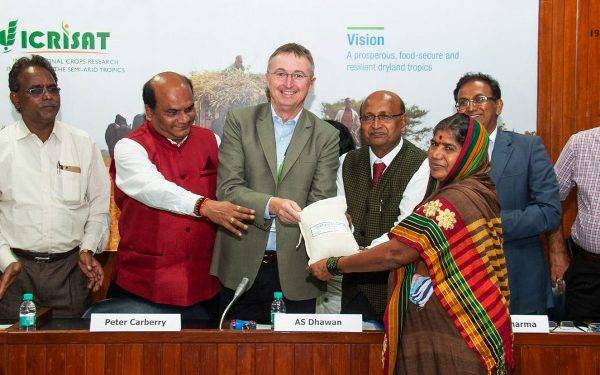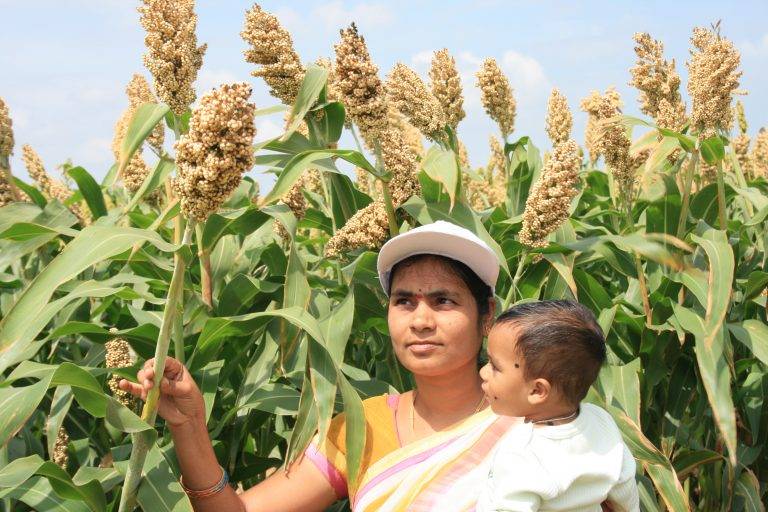
Sorghum, a cereal grain, is the fifth most important cereal crop in the world, largely because of its natural drought tolerance and versatility as food, feed and fuel. In Africa and parts of Asia, sorghum is primarily a human food product, while in the United States it is used mainly for livestock feed and in a growing number of ethanol plants.
Today different varieties of sorghum are grown in Asia, including India and Micronesia, and in both North America and Latin America. Sorghum kernels vary in color from white and pale yellow to deep reds, purples and browns; white, bronze, and brown kernels are most common.
India’s first biofortified sorghum (jowar), with significantly higher iron and zinc than regular sorghum, was formally launched. Developed by ICRISAT it was released for cultivation by Vasantrao Naik Marathwada Krishi Vidyapeeth (VNMKV), Maharashtra. The improved variety ICSR 14001, released as ‘Parbhani Shakti’ by VNMKV, offers a cost-effective and sustainable solution to address micronutrient deficiency.

This improved sorghum variety was developed by ICRISAT under HarvestPlus – sorghum biofortification project and was tested as PVK 1009 in Maharashtra state and in All India Co-ordinated Sorghum Improvement Project (AICSIP) Trials. It was released as a rainy season variety (Kharif) but it can be grown in post-rainy (Rabi) and summer seasons. The yield levels are higher (>5.0 t ha-1) in postrainy and summer seasons with irrigation. When grown in summer season, it can tolerate higher temperatures (41°C) at flowering and seed setting but the flowering may be delayed (80 days).
Farmers Smt Sunanda Shinde and Ahilyabai Shinde from Manoli village, Manvat TQ, Parbhani Dist who were part of the participatory field trials said, “We got a higher yield of 10-15 percent and it also has the preferred market traits. This makes it an attractive option and we are happy we are among the first farmers to use it.”
A MoU was signed today between ICRISAT and VNMKV for large-scale seed production and dissemination Speaking at the program to celebrate the launch, Prof A.S. Dhawan, Vice Chancellor, VNMKV said “We are glad to partner in this important initiative that offers a solution to a major concern like high anaemia rates among women and children in India. Extensive studies on Parbhani Shakti were carried out on our research fields and we are happy to partner in efforts that will have a bigger impact.”
Dr. Peter Carberry, Director General (Acting), ICRISAT said, “Our belief statement emphasizes that all people have a right to nutritious food. Biofortification is an important approach we take as it is cost-effective and sustainable. It addresses hidden hunger with no additional cost to its regular consumers and often sorghum is the cheapest cereal available in the market.”

Talking of the many advantages of the new variety, Dr Ashok Kumar, Principal Scientist, ICRISAT, said, “Parbhani Shakti developed through several years of work through conventional breeding has an average grain Fe concentration of 45 ppm and Zn 32 ppm. This is considerably higher than varieties that are currently being cultivated in India which have about 30 ppm Fe and 20 ppm Zn. Besides it has higher protein (11.9 percent ) and low phytate content (4.14 mg/100g) compared to 10 percent protein and 7.0 mg/100g phytates content in most sorghum cultivars. Low-phytate means increased bioavailability of nutrients. We are very happy that this kind of breakthrough has been achieved in India.”
The International Crops Research Institute for the Semi-Arid-Tropics (ICRISAT) is a non-profit, non-political organization that conducts agricultural research for development in Asia and sub-Saharan Africa with a wide array of partners throughout the world. Covering 6.5 million square kilometers of land in 55 countries, the semi-arid tropics have over 2 billion people, and 644 million of these are the poorest of the poor. ICRISAT innovations help the dryland poor move from poverty to prosperity by harnessing markets while managing risks – a strategy called Inclusive Market-Oriented development (IMO).
CGIAR is a global research partnership for a food-secure future. CGIAR science is dedicated to reducing poverty, enhancing food and nutrition security, and improving natural resources and ecosystem services. Its research is carried out by 15 CGIAR Centers in close collaboration with hundreds of partners, including national and regional research institutes, civil society organizations, academia, development organizations and the private sector.
HarvestPlus improves nutrition and public health by developing and promoting biofortified food crops that are rich in vitamins and minerals and providing global leadership on biofortification evidence and technology.HarvestPlus is part of the CGIAR Research Program on Agriculture for Nutrition and Health (A4NH). The HarvestPlus program is coordinated by two CGIAR centers, the International Center for Tropical Agriculture (CIAT) and the International Food Policy Research Institute (IFPRI).
The CGIAR Research Program on Grain Legumes and Dryland Cereals (GLDC), managed by ICRISAT with CGIAR partners, focuses on increasing productivity, profitability, resilience and marketability of critical and nutritious grain legume and cereal crops in Sub Saharan Africa and South Asia.
The CGIAR Research Program on Agriculture for Nutrition and Health (A4NH) led by the International Food Policy Research Institute (IFPRI), helps realize the potential of agricultural development to deliver gender-equitable health and nutritional benefits to the poor to help ensure that agricultural practices, interventions, and policies maximize benefits, while reducing health risks.















